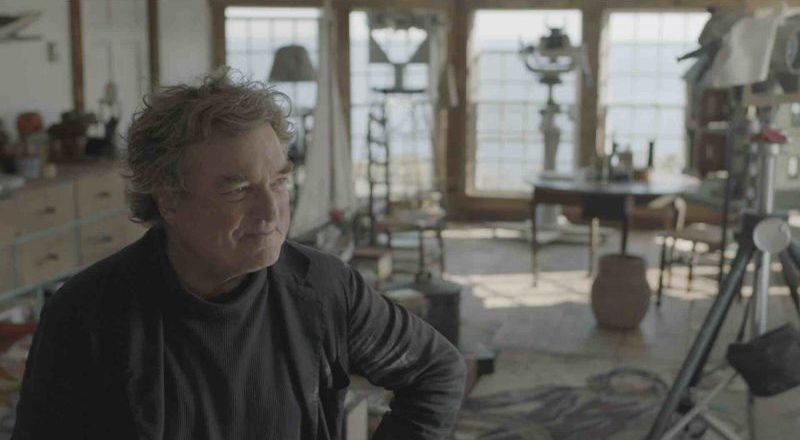INTERVIEW: Bringing Wyeth’s world to life on PBS
Jamie Wyeth, Andrew Wyeth’s son, at his home in Maine. Photo courtesy of Phil Bradshaw / Provided by PBS Pressroom with permission.
Hanging in New York City’s Museum of Modern Art is one of the most popular paintings of the 20th century. “Christina’s World” by Andrew Wyeth evokes almost instantaneous emotion in its viewers, and then the questions about its content arise.
A young woman in a pink dress is lying on a bed of tall grass and looking back at a farmhouse in the distance. Much of the painting is dominated by the rich yellows of the dying grass, and Christina’s eyes are not facing the viewer. There’s a sense of mystery and anticipation within this canvas.
Wyeth’s painting is a masterpiece, and the late painter has several works that could be classified as such. That’s why he is the subject of the new PBS American Masters documentary, Wyeth, which premieres Friday, Sept. 7 at 10 p.m. and is available for streaming Saturday, Sept. 8.
Recently, Hollywood Soapbox exchanged emails with the film’s director, Glenn Holsten. Questions and answers have been slightly edited for style.
What inspired you to tell the story of Andrew Wyeth for American Masters?
Like many people, I was a big fan of ‘Christina’s World; as a teenager, but I was formally introduced to Andrew Wyeth’s world in the mid-1990s, when I assisted another filmmaker (painter Bo Bartlett) on a documentary about Wyeth, titled Snow Hill. I loved working on that film, and became fascinated with Andrew Wyeth’s life and work. His life story is terrific — son of a famous illustrator, member of a remarkably creative family, early critical and financial success, subsequent critical backlash and condemnation, secret painting to fulfill creative desires … it’s a very rich story!
Mostly, however, I’m impressed with his strength and conviction to pursue the work he wanted to do, despite whatever criticism he received.
I’m so grateful that I had the chance to return to his world as a filmmaker, and had access to his work, and the places that had the most meaning to him in Chadds Ford, Pennsylvania, and Cushing, Maine.
How open were Wyeth’s family members to telling their stories?
I think there’s been enough time since his death (Andrew Wyeth died in 2009), that Andrew Wyeth’s sons have some thoughtful reflections on his life, and his contribution to the world. They seemed happy and eager to share. The same is true of neighbors and colleagues that we interviewed for the film. I got the sense that everyone was ready to tell their stories. Our job was to listen.
What special consideration goes into presenting art pieces in a documentary for television?
Filming paintings in a gallery space is extremely difficult. Some of the works are under glass, which causes reflections, and many times gallery lighting is not really camera-friendly. One thing that I do love about our film is that, because Wyeth’s world is such an interesting mash up of his physical world, we portray the places of significance to his work, so viewers are able to experience the locations as well and his interpretations of the people and spaces.
Do you feel the new film offers unknown revelations on this artist and his work?
I do. I think much has been discussed about Andrew Wyeth’s style of painting, but our film sheds new light on his process and choices. He would practically embed himself in locations for many years, continually looking at and painting the lives of the people (his neighbors) with whom he became fascinated. In addition, our film contains over 500 works of art — pencil sketches, watercolors, dry brush drawings, egg tempera paintings — that reveal his fascinating art-making process.
What do you hope the audience takes away from Wyeth?
Andrew Wyeth is a modern, inventive, incredibly gifted painter who painted his life. He found his neighbors and his neighborhood world enough for a lifetime of investigation. He created his own world, despite the criticism of the art establishment, and was true to his vision of what was worthy of painting. In that truth, there is drama, beauty and emotion.
By John Soltes / Publisher / John@HollywoodSoapbox.com
American Masters: Wyeth premieres Friday, Sept. 7 at 10 p.m. on PBS. Click here for more information.

